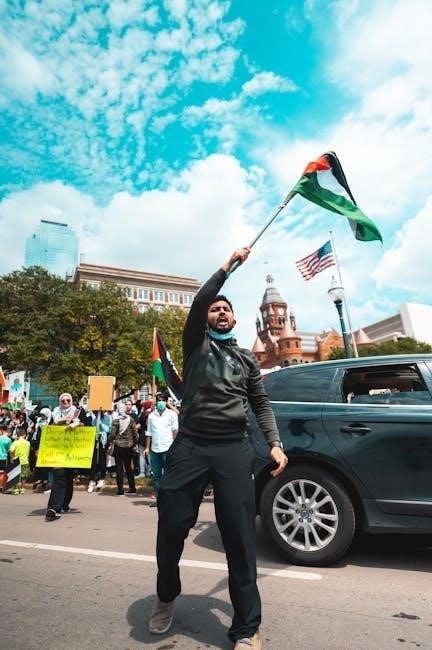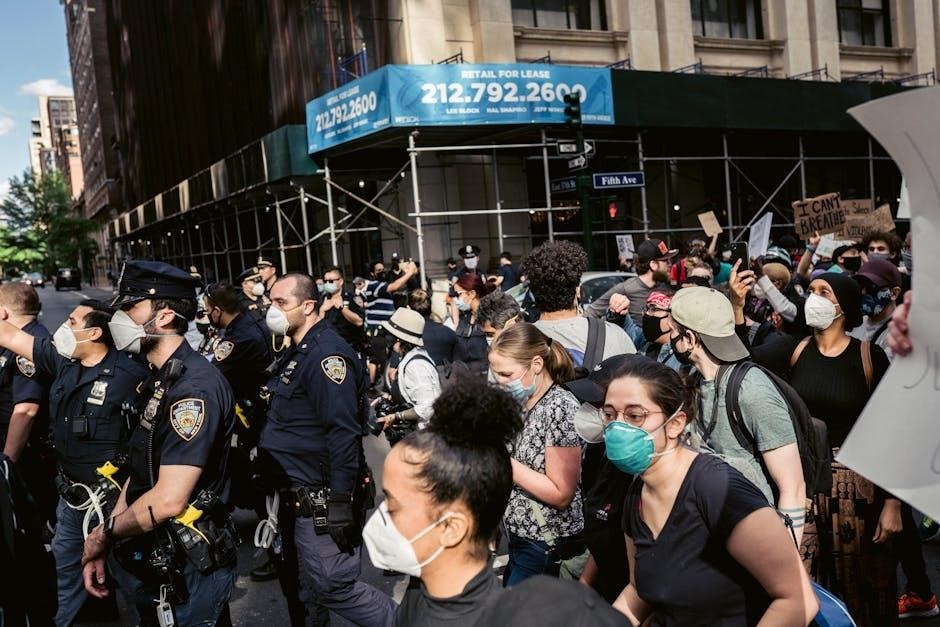
john lewis march pdf
Congressman John Lewis, a civil rights icon, shares his life’s struggle for justice in the “March” trilogy, a graphic novel series co-authored with Andrew Aydin and illustrated by Nate Powell. This vivid account bridges the past and present, offering a powerful reflection on the civil rights movement’s legacy and its relevance today. The trilogy not only chronicles Lewis’s journey but also serves as a testament to the enduring fight for equality, making history accessible to new generations through its compelling narrative and visual storytelling.
1.1 Overview of John Lewis’s Role in the Civil Rights Movement
John Lewis was a pivotal figure in the civil rights movement, dedicating his life to nonviolent activism and the pursuit of racial equality. As a young man, he co-founded the Student Nonviolent Coordinating Committee (SNCC), playing a central role in organizing pivotal events like the Freedom Rides and the Selma-Montgomery Marches. His unwavering commitment to justice led him to endure violent confrontations, yet he remained steadfast in his belief in the power of peaceful protest. Lewis’s leadership and courage earned him recognition as one of the “Big Six” civil rights leaders, alongside Martin Luther King Jr., shaping the movement’s trajectory and legacy.
1.2 The Significance of the “March” Trilogy as a Historical Account
The “March” trilogy stands as a monumental historical account, offering a firsthand narrative of John Lewis’s experiences during the civil rights movement. By blending personal reflections with broader historical context, the graphic novels provide an intimate yet comprehensive view of key events such as the 1963 March on Washington and the 1965 Selma-Montgomery Marches. This unique format makes the civil rights movement accessible to a diverse audience, ensuring that the struggles and triumphs of the era are not forgotten. The trilogy serves as both a educational tool and a powerful reminder of the ongoing fight for equality and justice.

Background on John Lewis
John Lewis was born into a sharecropping family in Pike County, Alabama, experiencing segregation firsthand. His early life inspired a deep commitment to civil rights activism, driven by the teachings of Martin Luther King Jr. and the influential comic book Martin Luther King and the Montgomery Story, which shaped his belief in nonviolent protest. This foundation laid the groundwork for his pivotal role in the civil rights movement, as documented in the “March” trilogy.
2.1 Early Life and Inspiration for Civil Rights Activism
John Lewis was raised on a cotton farm in Pike County, Alabama, where he experienced the harsh realities of segregation and racial inequality. Despite these challenges, his parents instilled in him a strong sense of self-worth and determination. Lewis found early inspiration in the comic book Martin Luther King and the Montgomery Story, which introduced him to the principles of nonviolent resistance. This exposure, combined with the teachings of Dr. King and the courage of Rosa Parks, ignited Lewis’s passion for civil rights activism, setting him on a path to become a leader in the movement.
2.2 John Lewis’s Involvement in Key Civil Rights Events
John Lewis was a central figure in pivotal civil rights events, including the 1961 Freedom Rides, the 1963 March on Washington, and the 1965 Selma-Montgomery Marches. As chairman of the Student Nonviolent Coordinating Committee (SNCC), he organized grassroots campaigns and faced brutal suppression, such as “Bloody Sunday” on the Edmund Pettus Bridge. His unwavering commitment to nonviolence and justice earned him national recognition and imprisonment multiple times. Lewis’s leadership and sacrifice were instrumental in advancing the civil rights movement, culminating in landmark legislation like the Voting Rights Act of 1965, forever changing the course of American history.

The Creation of the “March” Trilogy
John Lewis, Andrew Aydin, and Nate Powell collaborated to create the “March” trilogy, blending personal narrative with historical context to educate and inspire future generations about the civil rights movement.
3.1 The Vision Behind the Graphic Novel Series
The vision behind the “March” trilogy was to create an engaging, accessible narrative that would educate new generations about the civil rights movement. By using the graphic novel format, John Lewis, Andrew Aydin, and Nate Powell aimed to bridge the gap between past and present, making history relatable and vivid. The series not only recounts Lewis’s personal journey but also highlights the broader struggle for equality, emphasizing the power of nonviolent resistance and the importance of activism. This format was chosen to inspire young readers and ensure that the lessons of the civil rights era remain relevant and impactful.
3.2 Collaborative Efforts with Andrew Aydin and Nate Powell
The creation of the “March” trilogy was a collaborative effort between John Lewis, Andrew Aydin, and Nate Powell. Aydin, Lewis’s digital director, brought a deep understanding of the civil rights movement, while Powell’s evocative illustrations brought the story to life. Their partnership ensured that Lewis’s experiences were translated into a compelling narrative, blending historical accuracy with emotional depth. This collaboration not only preserved Lewis’s legacy but also made the civil rights movement accessible to a modern audience, proving the power of teamwork in storytelling and education.

Key Events Depicted in “March”
The “March” trilogy vividly portrays pivotal moments in John Lewis’s life, including the 1963 March on Washington and the 1965 Selma-Montgomery Marches, highlighting his resilience and commitment to nonviolent protest.
4.1 The 1963 March on Washington
The 1963 March on Washington was a landmark event in the civil rights movement, where John Lewis, as one of the “Big Six” organizers, played a crucial role. The march culminated in Martin Luther King Jr.’s iconic “I Have a Dream” speech, advocating for racial equality and justice. Lewis’s involvement highlighted his dedication to nonviolent protest and his vision for a unified America. The event drew hundreds of thousands, showcasing the power of collective action and setting the stage for significant legislative changes, including the Civil Rights Act of 1964. The march remains a symbol of hope and resilience.
4.2 The Selma-Montgomery Marches of 1965
The Selma-Montgomery Marches of 1965 were pivotal in the civil rights movement, as activists, including John Lewis, sought to secure voting rights for African Americans. The first march, known as “Bloody Sunday,” ended in violent repression by state troopers, drawing national attention. Lewis was beaten and hospitalized, but his resilience symbolized the movement’s determination. The subsequent marches, culminating in the successful 54-mile trek to Montgomery, led to the passage of the Voting Rights Act of 1965. These events, captured in “March”, underscore the sacrifices made for democracy and equality, leaving a lasting impact on American history and social justice.

Themes and Messages in “March”
The “March” trilogy explores themes of civil rights, nonviolent resistance, and racial inequality, emphasizing unity, resilience, and the moral imperative to challenge injustice, inspiring collective action.
5.1 The Struggle for Civil and Human Rights
The “March” trilogy vividly portrays John Lewis’s unwavering commitment to civil and human rights, detailing his journey from a sharecropper’s son to a congressional leader. It highlights the brutal realities of segregation and the courage required to challenge systemic racism through nonviolent protest. Lewis’s story underscores the moral imperative of equality, emphasizing the collective struggle for voting rights, desegregation, and justice. His experiences, from the Freedom Rides to the Selma-Montgomery Marches, illustrate the transformative power of resilience and unity in the face of oppression, inspiring future generations to continue the fight for human dignity and equality.
5.2 Reflections on Progress and Setbacks in the Civil Rights Movement
John Lewis’s “March” trilogy offers a poignant reflection on the civil rights movement’s triumphs and challenges, balancing hope with humility. It celebrates milestones like the March on Washington and the Selma-Montgomery Marches, yet acknowledges the setbacks, such as the violent resistance faced by activists. Lewis’s narrative bridges the gap between past and present, highlighting how the movement’s legacy continues to influence modern social justice efforts. His story serves as a reminder that progress is incremental and that vigilance is necessary to protect hard-won rights, inspiring readers to remain committed to the ongoing struggle for equality and human dignity.

The Role of Nonviolent Protest
John Lewis’s unwavering belief in nonviolence, inspired by Martin Luther King Jr. and the Montgomery Story comic, became a cornerstone of the civil rights movement, emphasizing moral strength and peaceful resistance to expose injustice and foster change.

6.1 John Lewis’s Commitment to Nonviolence
John Lewis’s dedication to nonviolence was deeply rooted in his spiritual beliefs and civil rights activism. Inspired by Martin Luther King Jr. and the Montgomery Story comic, Lewis embraced nonviolent resistance as a moral and strategic approach. He believed that enduring physical attacks without retaliation could expose the brutality of segregation and garner public empathy. This philosophy guided his participation in sit-ins, Freedom Rides, and marches, including the Selma-Montgomery Marches, where he faced severe beatings. His commitment to nonviolence not only shaped his actions but also became a defining principle of the civil rights movement, inspiring others to adopt peaceful protest as a powerful tool for change.
6.2 The Impact of Nonviolent Strategies on the Civil Rights Movement
Nonviolent strategies, championed by John Lewis and other leaders, profoundly shaped the civil rights movement. By enduring violence without retaliation, activists highlighted the moral injustice of segregation, gaining national attention and public support. The success of sit-ins, Freedom Rides, and marches demonstrated the effectiveness of nonviolence in challenging systemic racism. These tactics united diverse groups and pressured policymakers to enact landmark legislation, such as the Civil Rights Act of 1964 and the Voting Rights Act of 1965. Nonviolence not only achieved significant legal victories but also fostered a culture of peaceful protest, inspiring future social justice movements and solidifying its legacy as a powerful tool for change.

The Reception and Legacy of “March”
The “March” trilogy received widespread acclaim for its powerful storytelling and historical significance, earning awards like the National Book Award and inspiring modern social justice movements nationwide.
7.1 Critical Acclaim and Awards
“March” has garnered significant critical acclaim and prestigious awards. The trilogy earned the National Book Award for Young People’s Literature in 2016, solidifying its place as a landmark work. It also became a New York Times bestseller, highlighting its broad appeal and impact. The graphic novel’s vivid storytelling and historical depth have been praised by scholars and readers alike, making it a cornerstone of civil rights literature. Its recognition underscores the importance of John Lewis’s story and the innovative medium through which it is told, ensuring its legacy as an essential historical resource.
7.2 The Trilogy’s Influence on Modern Social Justice Movements
“March” has become a powerful tool for modern social justice movements, inspiring new generations of activists. Its graphic narrative format makes civil rights history accessible, bridging generational gaps. The trilogy’s themes of nonviolent resistance and grassroots organizing resonate with contemporary movements like Black Lives Matter and ongoing struggles for equality. Educators and advocates widely use “March” to teach the importance of activism and the lessons of the past. Its influence extends beyond academia, fueling conversations about systemic change and the enduring fight for human rights, ensuring John Lewis’s legacy continues to motivate future leaders in the pursuit of justice.

Educational Use of “March”
The “March” trilogy is widely used in educational settings to teach civil rights history. Its graphic novel format engages students, making complex historical events accessible and relatable for younger audiences.
8.1 Incorporating “March” into School Curricula
Schools are increasingly adopting the “March” trilogy as a core educational resource. Its graphic format makes it an engaging tool for teaching civil rights history, aligning with curriculum standards for middle and high school students. Educators praise its ability to convey complex historical events through a personal narrative, fostering empathy and understanding. The trilogy is often paired with discussion guides and activities, helping students connect historical struggles to contemporary social justice issues. This integration enriches students’ learning experiences, promoting critical thinking and a deeper appreciation for the ongoing fight for equality and human rights.
8.2 The Trilogy as a Tool for Teaching Civil Rights History
The “March” trilogy serves as a dynamic educational tool, offering a unique perspective on civil rights history. By blending personal narrative with historical events, it provides students with a relatable and immersive learning experience. The graphic novel format captures the attention of visual learners, making complex historical events more accessible. Educators use the trilogy to explore themes such as nonviolent resistance, voter suppression, and the role of youth in social change. Its vivid portrayal of iconic moments, like the Selma-Montgomery Marches, helps students grasp the emotional and societal impact of these events, enriching their understanding of the civil rights movement.

John Lewis’s Legacy Beyond “March”
John Lewis’s legacy extends far beyond the “March” trilogy, as his tireless advocacy for social justice continues to inspire global movements. His commitment to equality and nonviolence remains a cornerstone of his enduring impact, celebrated through numerous honors and memorials that ensure his story and principles endure for future generations.
9.1 His Continued Advocacy for Social Justice
John Lewis remained a steadfast advocate for social justice until his passing, continuing to champion civil rights and equality. His work in Congress and beyond emphasized grassroots organizing and nonviolent protest, inspiring modern movements like Black Lives Matter. Lewis’s unwavering dedication to justice ensured his legacy as a moral leader, guiding future generations to strive for a more equitable society. His story, as told in “March”, serves as a powerful reminder of the importance of perseverance in the face of injustice, ensuring his voice continues to resonate in the fight for human rights.
9.2 Memorialization and Honors After His Passing
Following John Lewis’s passing, he was honored with memorials in Washington, D.C., and his hometown, celebrating his enduring legacy. His funeral services reflected his impact, with tributes from national leaders and civil rights icons. The renaming of the Voting Rights Advancement Act in his honor underscored his pivotal role in the movement. The “March” trilogy earned critical acclaim, including the National Book Award, further cementing his influence. Lewis’s story continues to inspire, ensuring his commitment to justice and equality remains a guiding force for future generations, both through his legislative work and the vivid narrative of his life in “March”.
John Lewis’s story remains a beacon of courage and resilience. The “March” trilogy stands as a timeless historical resource, inspiring future generations to fight for justice and equality.
10.1 The Enduring Importance of John Lewis’s Story
John Lewis’s story transcends time, offering timeless lessons on courage, resilience, and the fight for justice. His journey from rural Alabama to Congress embodies the civil rights movement’s spirit. Through the “March” trilogy, Lewis shares his firsthand experiences, bridging generations and inspiring modern activists. His commitment to nonviolence and equality remains a powerful reminder of the progress made and the challenges still faced. Lewis’s legacy, as preserved in his graphic novels, ensures his voice continues to educate and motivate, solidifying his place as a moral leader in American history.
10.2 The “March” Trilogy as a Timeless Historical Resource
The “March” trilogy stands as a vital historical resource, blending personal narrative with broader civil rights history. Its graphic novel format makes complex events accessible, engaging diverse audiences. By detailing pivotal moments like the March on Washington and the Selma-Montgomery Marches, the trilogy educates on the movement’s sacrifices and triumphs. Lewis’s reflections offer insight into progress and setbacks, while its visual storytelling preserves history for future generations. As a tool for education and reflection, “March” ensures the civil rights movement’s lessons remain relevant, inspiring ongoing struggles for equality and justice in a changing world.